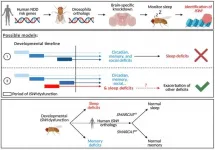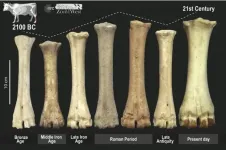(Press-News.org) A University of Sydney-led international team of scientists has revealed the shape of one of the most important molecular machines in our cellsthe glutamate transporter, helping to explain how our brain cells communicate with one another.
Glutamate transporters are tiny proteins on the surface of all our cells that shut on and off the chemical signals that have a big role in making sure all cell-to-cell talk runs smoothly. They are also involved in nerve signalling, metabolism and learning and memory.
The researchers captured the transporters in exquisite detail using cryogenic electron microscopy (cryo-EM), showing they look like a 'twisted elevator' embedded in the cell membrane.
This world-first discovery opens a whole new field of possibility, studying if defects in the transporters could be the reason behind neurological diseases such as Alzheimer's disease.
The results of the research have been published in Nature.
"The first time I saw the image was amazing. It revealed so much about how this transporter works and explained years of previous research," says PhD student Ichia Chen who was lead author on the study.
--A multitasking transporter---
The researchers were able to 'photograph' the structure of the glutamate transporter, by analysing thousands of images trapped in a thin layer of ice using cryo-EM, a highly sensitive microscope that made this research possible.
Cryo-EM can make visible what is invisible to the naked eye, using electron beams to photograph biological molecules.
The results also confirm suspicions the researchers had for some time that the glutamate transporters were multi-taskers.
"Using Cryo-EM, we have uncovered for the first time just how these transporters can multitask - carrying out the dual functions of moving chemicals (like glutamate) across the cell membrane while also allowing water and chloride ions to move through at the same time,"said senior author Professor Renae Ryan from the School of Medical Sciences, Faculty of Medicine and Health.
"These molecular machines use a really cool twisting, elevator-like mechanism to move their cargo across the cell membrane. But they also have an additional function where they can allow water and chloride ions to move across the cell membrane. We have been studying these dual functions for quite some time, but we could never explain how the transporters did this until now. Using a combination of techniques including cryo-EM and computer simulations, we captured this rare state, where we can observe both functions happening at the same time."
"Understanding how the molecular machines in our cells work enables us to interpret defects in these machines in disease states and also gives us clues as to how we might target these machines with therapeutics,"says Professor Ryan.
---Key to bridging the gap in diseases---
Mapping out in detail the structure of the glutamate transporter could be a crucial tool for researchers in understanding how our bodies work ,and the mechanism behind some diseases.
Defects in the glutamate transporter have been linked to many neurological diseases such as Alzheimer's disease and stroke.
This includes rare diseases such as episodic ataxia, a disease that impacts movement and causes periodic paralysis, caused by an uncontrolled leak of chloride through the glutamate transporter in brain cells.
"Understanding the glutamate transporter structure, which controls the normal flow of chloride, could help design drugs that can 'plug up' the chloride channel in episodic ataxia," says co-lead author Dr Qianyi Wu.
---Result of teamwork ---
The paper was the result of seven years of work from researchers in Australia and the United States.
The work also highlights the importance and potential of high-resolution microscopy to understanding biological processes.
"We are really excited to use the new Glacios Cryo-EM at the Sydney Microscopy and Microanalysis facility, University of Sydney. Having access to this microscope 'in house' will accelerate our research and our understanding of these important molecular machines," says Dr Josep Font, co-senior author of the study.
INFORMATION:
Almost one in five people lacks the protein α-actinin-3 in their muscle fibre. Researchers at Karolinska Institutet in Sweden now show that more of the skeletal muscle of these individuals comprises slow-twitch muscle fibres, which are more durable and energy-efficient and provide better tolerance to low temperatures than fast-twitch muscle fibres. The results are published in the scientific journal The American Journal of Human Genetics.
Skeletal muscle comprises fast-twitch (white) fibres that fatigue quickly and slow-twitch (red) fibres that are more resistant to fatigue. The protein α-actinin-3, which is found only ...
Robotic dogs, laughter therapy and mindfulness are some of the ways that might help people - particularly the elderly - cope with loneliness and social isolation while social distancing, say researchers at the University of Cambridge.
A team at Cambridge's School of Medicine carried out a systematic review looking at the existing evidence on different approaches to tackling loneliness and social isolation. While all the individual studies were carried out pre-pandemic, the team considered which approaches might be feasible when people are still required to socially distance. Their results are published today in PLOS ONE.
At the start of the pandemic in the UK, over 1.5 million people were told they must self-isolate ...
Lakes underneath the Antarctic ice sheet could be more hospitable than previously thought, allowing them to host more microbial life.
This is the finding of a new study that could help researchers determine the best spots to search for microbes that could be unique to the region, having been isolated and evolving alone for millions of years. The work could even provide insights into similar lakes beneath the surfaces of icy moons orbiting Jupiter and Saturn, and the southern ice cap on Mars.
Lakes can form beneath the thick ice sheet of Antarctica where the weight of ice causes immense pressure at the base, lowering the melting point of ice. This, coupled with gentle heating from rocks below and the insulation provided by the ice from the cold air above, allows pools of liquid water ...
WASHINGTON --- Recent data reveals that gay men living with HIV report having supportive relationships with family, friends, or in informal relationships rather than with primary romantic partners, while gay men who are HIV negative report having relationships mainly with primary partners. Additionally, gay men living with HIV were more likely to report no primary or secondary supportive partnerships compared to men who are HIV negative. The analysis was led by researchers at Georgetown University Medical Center.
Along with successful HIV treatments, it is known that the presence of social support impacts long-term survival among men living with HIV. However, little has been known about the types of ...
PHILADELPHIA - The mutation of a gene that has been associated with neurodevelopmental disorders like autism spectrum disorder led to marked sleep disturbances in fruit flies, according to a new study from scientists in the Perelman School of Medicine at the University of Pennsylvania. The findings, published Wednesday in Science Advances, provide further evidence that sleep is linked to early neurodevelopmental processes and could guide future treatments for patients.
While sleep disruption is a commonly reported symptom across neurodevelopmental disorders, including autism, it is often treated clinically as a "secondary effect" ...
In ancient European settlements, livestock use was likely primarily determined by political structure and market demands, according to a study published February 17, 2021 in the open-access journal PLOS ONE by Ariadna Nieto-Espinet and colleagues of the Consejo Superior de Investigaciones Científicas, Barcelona.
Zooarchaeology - the study of animal remains from archaeological sites - has great potential to provide information on past human communities. Livestock preferences are known to have changed over time in Europe, but little is known about how much these changes are influenced by environmental, economic, or political conditions of ancient settlements.
In ...
The new method works without extremely high temperatures, is therefore more energy-efficient and has a significantly higher recovery rate (approx. 96 per cent of the starting material) than established processes. These findings will be published on 17 February 2021 in the scientific journal Nature.
Mechanical recycling vs. chemical recycling
"The direct re-utilization of plastics is often hampered by the fact that, in practice, mechanical recycling only functions to a limited degree - because the plastics are contaminated and mixed with additives, which impairs the properties ...
Engineers at the University of California San Diego have created a four-legged soft robot that doesn't need any electronics to work. The robot only needs a constant source of pressurized air for all its functions, including its controls and locomotion systems.
The team, led by Michael T. Tolley, a professor of mechanical engineering at the Jacobs School of Engineering at UC San Diego, details its findings in the Feb. 17, 2021 issue of the journal Science Robotics.
"This work represents a fundamental yet significant step towards fully-autonomous, electronics-free walking robots," said Dylan Drotman, a Ph.D. student in Tolley's research group and the paper's first author.
Applications include low-cost robotics for entertainment, such ...
The unprecedented and deadly blazes that engulfed the American West in 2020 attest to the increasing number, size and severity of wildfires in the region. And while scientists predict the climate crisis will exacerbate this situation, there's still much discussion around its contributing factors.
With this in mind, scientists at five western universities, including UC Santa Barbara, investigated the effects of human-driven climate change and more than a century of fire suppression, which has produced dense forests primed to burn. Their research, published in the journal Environmental ...
In the search for planets capable of sustaining life, an international research team with members from ETH has taken a significant step forward. As the researchers reported recently in the journal Nature Communications, they found signs of a Neptune-sized planet in the Alpha Centauri star system, a mere 4.4 light years away from Earth. This exoplanet is located in a zone that may offer suitable conditions for life. The team was able to collect data with unprecedented sensitivity, thus registering even very weak signals.
Earth is a disruptive factor
Thanks to the new process, the researchers have advanced one step closer to ...



